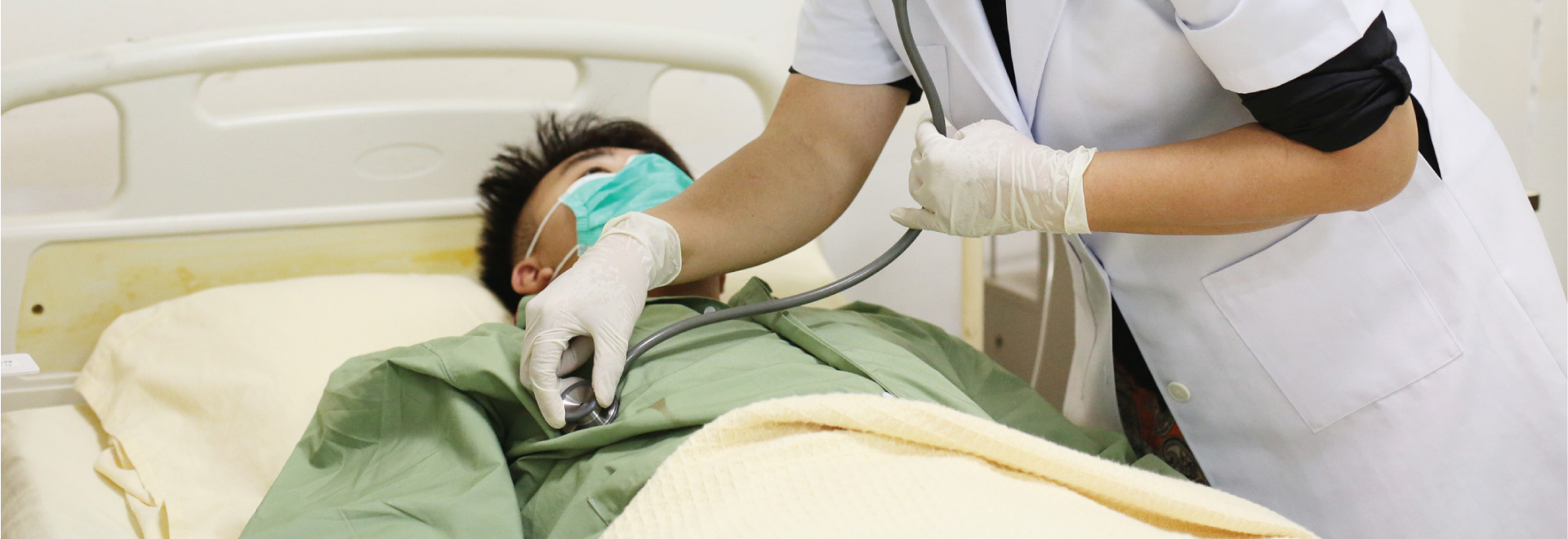Pulmonary edema is not a complication that only happens to the elderly but also to younger people. A customer of Cigna, Thomas, went to the A&E department of a public hospital for symptoms caused by pulmonary edema and pneumonia. He later wished to be transferred to a private hospital for treatment. Her wife finally turned to Cigna for help. The case then was followed up by Cigna's Care Manager, including explaining the risks that may arise during the transfer to allow the family members to understand the patient's situation and circumstances.
Admitted to Hospital Due to Sudden Dyspnoea and Chest Pain
Thomas, who was in his thirties, suffered from headaches, chest pain, and so on at the beginning of his illness and his condition became worse at a later stage with symptoms such as dyspnoea and foot edema. He originally planned to seek medical attention in private hospitals. Due to the severe COVID-19 outbreak, the private hospitals could not receive such patients because of the shortage of negative pressure rooms. Thomas, accompanied by his wife, went to the A&E department of a public hospital and was hospitalized for medical treatment.
Wishing to Be Transferred to Another Hospital after Being Diagnosed with Pulmonary Edema and Pneumonia
Thomas was diagnosed with pulmonary edema and pneumonia. He was tested negative for COVID-19, which means he is not infected. The hospital has also failed to identify the pathogen of the pneumonia. Worried about her husband's worsening condition, Thomas's wife wanted to transfer him to a private hospital for better treatment.
Rescued at ICU
After learning about Thomas's situation, Care Manager explained to his wife the risks that might arise during the transfer, including worsening of the condition and the increased risk of being infected with COVID-19. Unfortunately, Thomas's condition got worsened and was sent to ICU for rescue. He had to rely on breathing apparatus for high concentrations of oxygen to maintain his life.
When Thomas was in the ICU, Care Manager contacted Thomas’s wife every day to learn about the changes in the customer's condition and provide support when needed. Meanwhile, the Care Manager also provided mental support to his wife to reduce her anxiety and stress.
When Thomas has passed his crisis, his wife and the Care Manager in charge were relieved. As Thomas’s condition stabilized gradually and he was recovering and discharged, the Care Manager contacted a private hospital for Thomas's follow-up consultation, including long-term follow-up by specialists in departments such as cardio-thoracic surgery and cardiology.
Pulmonary Edema to be Treated on a Case-by-case Basis Due to Various Causes
Pulmonary edema (i.e. pleural effusion) refers to the excessive fluids in the thorax area outside the patient's lungs and is divided into "transudative" and "exudative" ones. They have different causes and treatment and the care needed varies from person to person. The former type is mostly caused by more serious long-term diseases such as heart failure, cirrhosis or kidney failure, and usually occurs on both sides of the patient's chest cavity. The latter one is usually caused by pleurisy, cancer or tuberculosis and appears on only one side. In addition, some rheumatic diseases, such as systemic lupus erythematosus and rheumatoid arthritis might also give rise to pulmonary edema.
If the amount of fluid accumulated in the lungs is not significant, the patient may not have obvious symptoms. However, further accumulation of fluids may lead to more severe symptoms as the following:
- Rapid breathing or shortness of breath
- Cough
- Chest pain
- In the case of pulmonary edema resulting from pneumonia or tuberculosis, patients may have fever and sputum
Clinically, doctors can further identify the cause of pulmonary edema by examining lung tissues using X-rays, computer scans, ultrasound, and so on. If it is found that the pulmonary edema results from pneumonia, which means the fluids contain bacteria or white blood cells, the doctors will siphon off the fluids and prescribe antibiotics. If a patient's pulmonary edema is caused by kidney failure, the kidney failure should be kept under control first, by measures like taking medications or kidney dialysis. In the case of lung cancer, patients must also receive appropriate cancer treatment to reduce the fluids in the lungs by controlling the tumor.
Cigna’s Care Manager Provides You with Heart-warming Services
At present, Cigna’s customers can receive our Healthcare Concierge Service when receiving treatment, including a dedicated Care Manager for follow-up. The services are as follows:
- Staffed by registered nurses and provide customers with professional advisory if they are facing health issue
- Understands and analyzes the health condition of customers, and offers network doctor options
- Coordinates and follows up on hospital surgery or treatment arrangements and post-surgery visit
- Provides information on improving health, and post-discharge follow-up in person(for example, arranging post-discharge physiotherapy, nutrition guidance, meal delivery service, and more)
- Refers you to personalized services (for example, local limousine transportation to the hospital, nursing arrangements, virtual consultation, medication delivery, home modification, and more)
- Provides emotional support for customers and their family
- Helps arrange “Cigna Health Services At Home” to reduce the risk of infection
The above content is adapted from real cases. Should you have any questions regarding the above case, please contact Cigna for inquiries.
The content of the article cannot substitute for professional opinions or diagnosis of the attending doctors. Should you have any questions regarding the medical treatment plan, please consult your attending doctor.
The content of the above article is for reference only, and Cigna does not warrant or make any representation regarding the accuracy and completeness of the related content and information. Cigna shall not be liable for any damages, indemnities, costs or other expenses arising out of the related content and information.
Cigna HealthFirst Elite 360 Medical Plan offers comprehensive and personalized medical coverage across the stage prevention, diagnosis, treatment and recovery, with a range of hospital and surgical benefits, optional insurance benefits with an annual limit of up to HK$50 million, personalized health assessment, three critical illnesses(cancer, stroke and heart attack) all-rounded care and international medical concierge service. A 360-degree total health protection that spans across all the key stages of your health journey. Learn more here.
The above insurance product information is directly provided by Cigna, and the relevant information is not the content and features of all the coverage of the insurance product. The designated insurance plan is bound by its policy terms. Please visit the Cigna website and refer to the relevant product brochures and policy terms for details of features, contents, terms, conditions and exclusions of relevant products. The above information cannot be used as an insurance contract executed between Cigna and any person or group or as an offer, invitation or lobbying to enter into any insurance contract.


